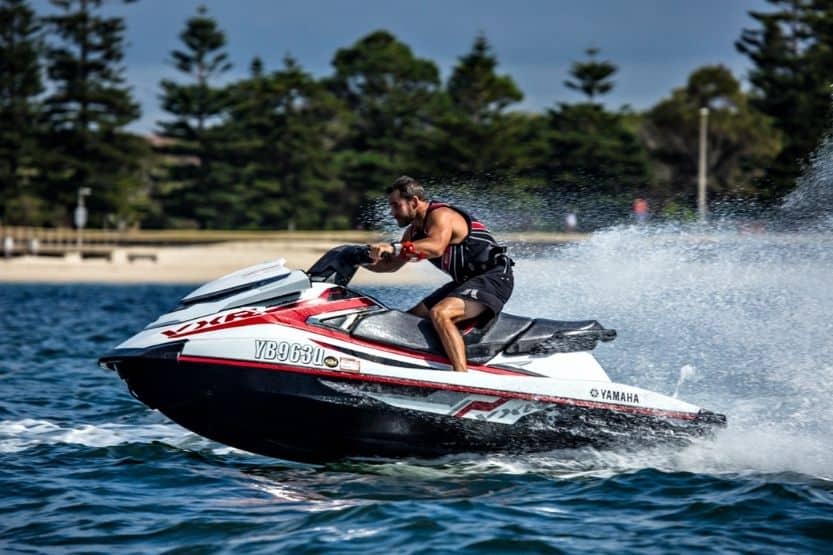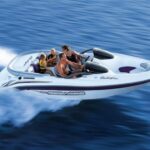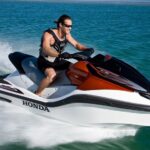Unlike other personal watercraft, the Yamaha VXR did not follow the usual formula of slapping a supercharger onto the engine to make it go faster. Instead, Yamaha engineered an exceptional power-to-weight ratio, allowing it to easily hit speeds above 60 miles per hour.
The Yamaha VXR has the biggest engine in the entire Wave Runner line. This makes it capable of keeping up with other PWCs that come with intercoolers and superchargers. It was also the first to use the lightweight material NanoXcel for its hull. This makes it one of the lightest PWCs in the market.
The VXR is also relatively affordable, which makes it appealing to beginner riders. Although easy on the budget, it delivers high performance and is built to last.
Read on to learn more about the Yamaha VXR jet ski and its naturally aspirated engine.
About the Yamaha VXR

In the entire Wave Runner line, the Yamaha VXR has the biggest engine. This allows it to keep up with other PWCs with intercoolers and superchargers. Aside from its engine, it is also attractive due to its price.
The Yamaha WaveRunner VXR jet ski first came out in 2011. It was the first to use the lightweight material NanoXcel for its hull. This makes it the lightest of all the existing PWCs at the time.
Paired with a high-output 1.8L engine, the VXR had an exceptional power-to-weight ratio. This allows it to hit speeds above 60 miles per hour easily.
Don’t let the introductory hull design fool you. The VXR is surprisingly agile. The engine’s immense power makes this PWC aggressive at taking corners. It can also reach incredible speeds along the straightaways.
Do not expect too much in terms of bells and whistles with the VXR, common in modern PWCs. The Yamaha VXR is as basic as they get. But it can be quite liberating to ride a machine without any additional gadgets to tinker around with; ride it and ride it hard.
Yamaha VXR Specs and Features
Engine
Power comes from a 1.8L, 1,812cc displacement, 4-cylinder, 4-stroke, Yamaha High Output engine. The huge displacement means that the VXR jet ski does not need to rely on forced air. The engine itself is enough to launch this WaveRunner and send it shooting across the water.
Throttle System
Yamaha equipped this PWC with the RiDE system, which is basically a dual-throttle system. The right lever controls the craft’s forward movement, while the left controls the reverse.
Combining the two levers’ use provides the rider with optimal control over the acceleration and deceleration of the VXR.
Race-inspired Seats
The seat combines comfort and grip. Meaning, you can comfortably ride this PWC for hours. But you can still be able to make tight turns without slipping off the seat. The seat is also designed to carry the rider and two more passengers. Although, it might be a tight squeeze for them.
Multi-functional Display
A center-mounted LCD shows the speed, fuel level, and other basic engine readouts. The display is large and clear enough that it is quite easy to read even when it is bright outside.
Hull and Deck
Most of this PWC’s body is made using Yamaha’s NanoXcel material. This material provides the craft with utmost rigidity and strength. At the same time, cutting down the total weight of the craft significantly.
Storage Compartments
There is plenty of storage space in the VXR jet ski, more than enough space to hold everything that you will need for an entire day of fun on the water. The jet ski also has a large compartment in front for a tow cable, fire extinguisher, and maybe even a small cooler for drinks.
Lastly, there is also one smaller compartment below the handlebars that can fit a phone and wallet and another one is under the aft rear seat.
Yamaha VXR Top Speed
Because of the VXR’s lightweight body and its large 1.8L engine, it does not have any problem pushing the craft to its maximum speed of 65 miles per hour. It can even go faster depending on the condition of the water.
The High Output Yamaha engine can push the VXR from 0 to 30 miles per hour in just 1.7 seconds. Also, the intake grate has a design that can allow more water into the jet-drive; thus, producing more thrust.
Aside from that, Yamaha made sure that the steering is dialed in accordingly. It designed the seat so that the rider would not fly off when the VXR PWC suddenly blasts off and when it does really tight turns.
At 4000 RPM, you will hit the best cruise of the Yamaha VXR. At this point, the VXR will be cruising on the water at roughly 20 miles per hour, and it will be consuming fuel at an average of 8 miles per gallon.

This means that the 18.5-gallon fuel tank can take the Yamaha VXR to a distance of 135 statute miles, which is actually not bad for a PWC. A full tank of gas will be more than enough for an entire day of fun on the water.
The Yamaha VXR’s RiDE System
One of the best features of the Yamaha VXR is its RiDE system. This PWC comes with a lever throttle, just like the others, but this has two levers. The right one controls the throttle, and the left one controls the deceleration and reverses gear.
The way it works is simple. If you start the engine, the “gear” of the VXR is neutral. Pull the right lever, and it will cause the craft to move forward. Pull the lever on the left handlebar while still holding on to the right one, and it will slow down the craft, acting as a brake.
Letting go of the right lever and pulling on the left will completely stop the craft and put it back into neutral. Put the craft in reverse, pull on the left lever fully and then pull on the right to push the VXR in reverse.
You will find that the thrust jets would be coming from the sides of the Yamaha VXR jet ski instead of the rear.
This remarkable dual throttle system is so easy to pick up that many first-time PWC riders will have no problem using the VXR and have a lot of fun with it.
Increasing the VXR’s Power
If you are not satisfied with the stock engine of the VXR and you want it to go even faster, there are certain modifications that you can make to it.
Here are just a few of them:
An Improved Air Intake System
One way to improve the performance of a natural-aspirated engine like the High Output from Yamaha is to install an aftermarket performance intake system.
You usually mount inside the front compartment – a new and larger bulkhead to draw more outside air into a performance air filter and the engine.
More air means fuel will combust more readily. This can make your ride much more responsive and powerful. It can also result in better fuel efficiency.
Replace the Stock Air Filters
Replacing the stock filters with high-performance ones will let the engine get more air without sacrificing filtering capabilities. You can accomplish this by using a much bigger air filter.
More air can go through the filter with a larger surface area, preventing dust and debris from getting past it.
Re-tuning the ECU
Adding more horsepower without adding components is simple. You have to flash the onboard ECU then re-format it using a new tuning program. It will slightly or fully disable the limiters that control the fuel injection to burn more fuel.
Combine performance with the improved air intake system and the improved ECU, and you will take the VXR well beyond its stock 65 miles per hour top speed, as well as improve fuel efficiency.
Install a Performance Impeller
Replacing the stock impeller with larger blades and cowl will help push more water into the jet-drive, helping propel the craft faster. Don’t worry that the VXR cannot handle a larger impeller.
With the high output engine’s massive size, simply changing the impeller will not put too much strain on it.
Install a Performance Exhaust
A high-performance exhaust system allows the engine to “breathe.” They usually do away with the sound suppressor to remove any chance of back-pressure. Moreover, it makes the engine sound so much better.
These are relatively simple modifications, there is no need to alter anything in the engine, and you will be making the machine even lighter. You need to replace a couple of parts to make the already powerful High Output engine work more efficiently.
Yamaha VXR Pros and Cons
Pros
- Affordable, yet high performance – It would not be easy to find other deals just like the Yamaha VXR. Because the engine is “only” a naturally-aspirated without any superchargers and there are little in terms of bells and whistles, Yamaha can bring down the price of the VXR quite low, but that does not mean it can’t compete with more expensive brands and models with turbos and the like.

- Has a retracting rear deck step – If you are wiping out while on your VXR, which is a likely occurrence, you will discover that it is easy to get back on board because of the spring-loaded rear step. A non-slip wrap also covers the deck itself, so you will find it easy to find your footing.
- Effective security features – The automotive-style key fob remote of the VXR can lock the ignition, thus preventing theft. If someone does manage to hardwire the ignition of the VXR, which is a feat in itself, the key fob also comes with a slow-speed mode, so the perp will not get too far.
- Easy to access oil filter – Unlike some of the other PWCs out there, you can easily access the oil filter from the engine compartment. You do not need to remove any paneling at all. This is important since you will be replacing it quite often when you do periodic maintenance.
- Low maintenance – The great thing about naturally-aspirated engines, like the High Output engine of the Yamaha VXR, is that they are usually low-maintenance. You can get hundreds of hours of use before you can find any issues. Moreover, if you encounter a problem, it is usually a pretty easy fix.
Cons
- The dashboard is pretty basic – The only things you will find on the sparse dashboard of the VXR include a speedometer, a basic tachometer, and the fuel gauge. If you like to monitor your PWC’s health, you may be disappointed at just how little information you can get from the VXR’s dashboard.
- The seat is too small – Yamaha marketed the VXR as a three-seater, but you can be sure that the third person will not have a relaxing ride because they will barely even sit. The seat of the VXR is really just a comfortable two-seater.
Yamaha VXR vs. Sea-Doo RXT 260
The closes competitor to the Yamaha VXR might be the Sea-Doo RXT 260. In terms of top speed, both PWCs can easily reach 65 miles per hour. Both have similar acceleration, with the Sea-Doo being a bit quicker.
Regarding handling, both vehicles are easy to handle and steer, especially at low speeds.
However, what makes the Yamaha VXR the better choice among the two is that it costs a couple of thousand dollars less than the Sea-Doo. You can use all that money to buy performance parts for the VXR, making it run at par with other PWCs in a much higher price range.
Conclusion – Yamaha VXR Review and Specs
One of the reasons why the Yamaha VXR is so endearing to many PWC enthusiasts and beginners to the sport is its very reasonable price tag. However, even though the VXR is affordable, it is no slouch.
With a very impressive power-to-weight ratio, the VXR does not need a turbo to keep up with PWCs in a much higher price bracket.
If you are in the market for a fun yet affordable personal watercraft, you should check out the Yamaha VXR. You will never regret your decision to invest in it.





![Amel Sailboat Review [50, 60, Super Maramu, Kirk] amel sailboats](https://boatinggeeks.com/wp-content/uploads/2021/06/amel-sailboats-150x150.jpg)
![Freedom Boat Club Cost [Freedom Membership Cost and Review] freedom boat club cost](https://boatinggeeks.com/wp-content/uploads/2021/07/freedom-boat-club-cost-150x150.jpg)

![Read more about the article How Much Is a Jet Ski? [New and Used Jet Ski Prices]](https://boatinggeeks.com/wp-content/uploads/2021/08/how-much-is-a-jet-ski-300x200.jpg)
